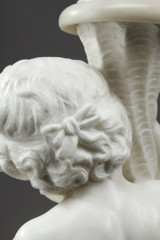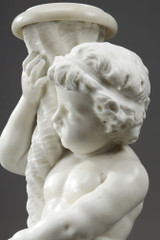Pair of sculptures in white Carrara marble, made in Italy at the end of the 19th century. These mythological statuettes represent two putti holding a cornucopia in the shape of a newt shell. Each putto, wrapped in a drape, stands in contrapposto. One is wearing a ribbon ending in a bow.
Putti ("putto" in the masculine) are nude male child figures, generously shaped, wingless (unlike the Amorino) and laughing, inspired by Greek art and Ancient Rome.
In Greek mythology, the horn of plenty is a symbol of wealth and fertility. One version evokes the horn of the goat Amalthée , which suckled Zeus when he was still a child, producing nectar and ambrosia to make him immortal.
In Ovid's splendid works, the legend evolves: Amalthée the goat is transformed into a nymph. Rhea, mother of Zeus, who entrusted her child to protect him from his father Cronos, who had been told that one of his children would depose him. She takes care of the young god by feeding him with the milk of a goat; but the goat breaking one of its two horns, "Amalthée picked it up and surrounded it with fresh herbs, filled it with fruit, and thus presented it to Zeus' lips". This emblem is often found on beneficent divine figures such as Bacchus, Ceres, Cybele or Fortune.
A pair of decorative saddles adorned with crystal cone vases is also available.
Circa: 1890
Dimensions putti with ribbon: W: 24 cm x D: 21 cm x H: 68 cm
Dimensions putti without ribbon: W: 26 cm x D: 21 cm x H: 66 cm
Dimensions base: 21 cm x 21 cm (8.3 in x 8.3 in)
Dimensions tray: 10.5 cm x 10.5 cm (4.3 in x 4.3 in)
Overall dimensions: W: 24cm, D: 21cm, H: 68cm (W: 9.4in, D: 8.3in, H: 26.8in).
Condition report: In good condition.
- Reference :
- 3270
- Width :
- 24 (cm)
- Height :
- 68 (cm)
- Depth :
- 21 (cm)
- Period::
- 19century
- Style ::
- Neo-classical
- Materials::
- Carrara marble, crystal, bronze
- Identifier Exists:
- False











































